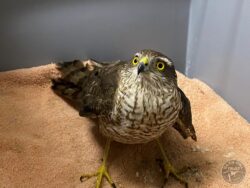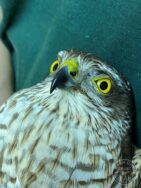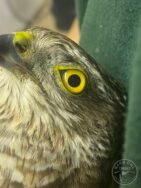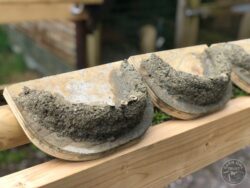 The month began dry, and the Lesser Stitchwort and Birdsfoot Trefoil had begun flowering in the grassland alongside the Germander Speedwell. The Skylark was seen and heard again on the 1st over the Main Field. On the 2nd a Heron was seen on the river below the top bridge and on the 3rd a Slowworm and a Toad were once again under the corrugated sheet near the First Field Shelter. Harry has been constructing artificial Swallow cups for the 2nd Field Shelter this month.
The month began dry, and the Lesser Stitchwort and Birdsfoot Trefoil had begun flowering in the grassland alongside the Germander Speedwell. The Skylark was seen and heard again on the 1st over the Main Field. On the 2nd a Heron was seen on the river below the top bridge and on the 3rd a Slowworm and a Toad were once again under the corrugated sheet near the First Field Shelter. Harry has been constructing artificial Swallow cups for the 2nd Field Shelter this month.
We haven’t seen any sign of Sunflowers germinating in the winter bird food crop which was sown on the 24th April, This is quite remarkable as we sowed about 12kg of seed. We think that the Rabbits and or the Slugs must be nibbling them off as soon as they emerge. Fortunately some of the other seeds are starting to grow.
On the 7th Harry and Pip completed the new Goat bed in the 2nd Field Shelter and the Goats were shut in Kiln Close to get used to their new home. More than four Slowworms were curled up together under the sheet of corrugated closest to the gate at the top of the Main Field and under the other sheet, closest to the 1st Field Shelter, the Toad was still there along with a Slowworm and a Field Vole that appears to have made a nest of dried grass. A Skylark was singing over the Airstrip on the 9th.
Volunteers helped Harry pull Creeping Thistle on the 11th and 13th, there were loads of Garden Chafers about and quite a few crickets. They also found a dead Hedgehog in the middle of Main Field near the airstrip, being eaten by maggotsand saw Six Spot Burnet Moth caterpillars on the Bird’s-foot Trefoil patches. White (Barn Owl) droppings had appeared at the back of the First Field Shelter on the 14th.
An inspection of the pond in torchlight on the 15th revealed at least two Trout, 8” and 6”, in the Flo Pond despite it being murky because of the rain. On the 18th Harry mowed most of the paths with the tractor for the first time since his training course, David completed the steep parts on the 20th.
- Great Green Bush Cricket
- Garden Chafer
There have been noticeably less Butterflies around this year, even the whites which usually appear in April have been noticeable by their absence. We have recorded more rain than usual here every month since July 2023 and the mean temperature here for June (to the 20th) is 1.6°C less than our 19-year average which is likely to have affected them.
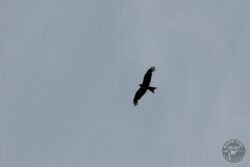 Very exciting lunch time walk on the 20th , first a male (blue) Beautiful Demoiselle by the Flo Pond, an 8” Trout in the pond and then great views of a Red Kite soaring over the LLP for about 10-minutes before it was chased off by a flock of Gulls. It was probably a sub-adult passing through, but this is only the 5th record here and the longest visit. They were recorded passing over in June 2013, June 2018, March 2019 and March 2022.
Very exciting lunch time walk on the 20th , first a male (blue) Beautiful Demoiselle by the Flo Pond, an 8” Trout in the pond and then great views of a Red Kite soaring over the LLP for about 10-minutes before it was chased off by a flock of Gulls. It was probably a sub-adult passing through, but this is only the 5th record here and the longest visit. They were recorded passing over in June 2013, June 2018, March 2019 and March 2022.
Two small bird boxes were erected on the east side of the Kiln Close Field Shelter on the 24th and a Kestrel was seen flying over the Main Field. The first Marbled White was spotted on the 25th but very few of any kind of butterflies around so far this year.
An injured Sparrowhawk was seen in the drive and later caught in a neighbour’s garden and brought in for treatment.
On the 26th fourteen members of the Ashburton and District Gardening Association joined us for an evening walk around the LLP followed by refreshments in the Meeting Room. We were blessed with perfect weather.
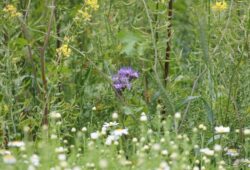 A new plant has crept into the winter bird food crop, Common Fiddleneck (Phacelia tanacetifolia). We think it must have come in inadvertently with the seed as its native to America. It is an annual with soft blue or lavender-blue flowers and apparently very attractive to bees and other insects.
A new plant has crept into the winter bird food crop, Common Fiddleneck (Phacelia tanacetifolia). We think it must have come in inadvertently with the seed as its native to America. It is an annual with soft blue or lavender-blue flowers and apparently very attractive to bees and other insects.
With predominantly North Westerly winds during June the mean temperature for the month was 0.6°C cooler than our 19-year average and 2.8°C cooler than June 2023. We had just 24.2mm of rain (average here 61.21mm) over 7 days.



